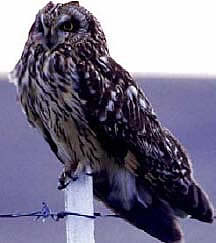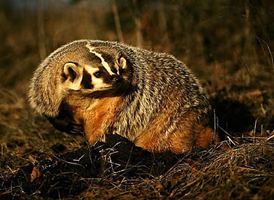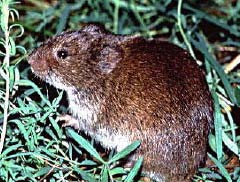A large literature exists on the impacts of habitat disturbance and fragmentation on vertebrate populations. However, the literature reveals little evidence of terrestrial wildlife exposure to hydrocarbons at oil and gas E&P sites. Preliminary evidence suggests there is little uptake of hydrocarbons by plant species, and that hydrocarbons are avoided by earthworms (a prime food for lower vertebrates). Most terrestrial vertebrates tend to avoid contaminated sites and visible E&P activity sites such as well pads. ORNL and LLNL focused their research on developing a method to study and model species relationships to habitat disturbances.
The Tallgrass Prairie Preserve is a 15,200 hectare area owned by the Nature Conservancy in Osage County, OK. There are 600 non-producing and 120 active oil and gas wells on the preserve. One percent of the area is disturbed by spills, well pads, and oil-related production facilities. The area covered by brine spills is less than 0.1% of the preserve. The native vegetation and terrestrial vertebrate species exist in a mature and healthy grassland community, making it a prime locality to study the effects of oil and brine spills on population densities.
Project Results
The project developed spatially explicit individual-based models (IBMs) for terrestrial vertebrates. The strength of IBMs is in their ability to simulate linkages between the physical environment-as modified by human activities (such as oil production)-and animal populations. ORNL focused on the development of a population model that used habitat suitability index as the basis for representing spatial variation in habitat of the American badger, Taxidea taxus. LLNL focused on the relationship between prairie voles and short-horned owls. The badger and the owl represent the top predators in the food chain, or trophic level. Trophic interactions were used to model and define the degree of habitat disturbance caused by brine spills. The badger model showed a steady increase in population (away from the immediate spill areas), until the population reached carrying capacity with annual pulses corresponding to spring births.
Benefits
Simulation of the impacts of fragmentation caused by different patterns of new roads and wells on vertebrate populations provided valuable data on the impact of spills and petroleum development on terrestrial vertebrates. The project recommendations can be used to provide a useful tool for developing good management practices for new road and well development during petroleum exploration and production. The data also provide knowledge on the development of spatial decisions for locating new wells or restoring spills or old well pads. By providing a database and a model of impact on terrestrial vertebrates, the project offers valuable information on well siting, disturbances, and vegetative restoration to minimize effects on population densities.
Project Summary
ERA is a tool used by many regulatory agencies to evaluate the impact to ecological receptors from changes in environmental conditions. Typical ERAs are toxicologically based, require complex modeling of transport and exposure, and are very labor-intensive. The current effort is to streamline the ERA process and to identify ecological screening criteria for excluding sites from formal risk assessment. By considering spatial context, it should be possible to develop mitigation and monitoring efforts to more appropriately address E&P sites within the context of an ecological framework.
The project compared simulated badger population sizes when brine spills are added to the trophic model. The prairie vole and other small rodents and birds are the prime prey for both the badger and the short-horned owl. Scenarios studied the effect of one large brine spill and many small spills of the same size.
The disturbance patterns at E&P sites that may impact terrestrial vertebrates include:
- Brine spills.
- Bare ground, denuded of vegetation.
- Erosion.
- Slow recovery and area of difficult restoration.
- Hydrocarbon spills.
- Biodegradation, enhanced remediation.
- Rapid recovery, given enough nutrients.
- Slower recovery if plants are sprayed.
- Wellheads, well pads.
- Large number of small, isolated disturbed areas.
- Pipelines.
- Roads.
Other management disturbances.
- Grazing (bison are the major grazing species on the preserve).
- Prescribed burns.
- Mowing.
The study found several links from habitat disturbance to population-level effect:
- Individuals unable to find territories may emigrate.
- Movement costs may increase for animals that avoid or do not settle in disturbed areas.
- Forage vegetation or prey may be less available.
- Animals may be unable to find mates or breeding territories.
- Remaining habitat may provide fewer refuges from predators.
The habitat-based model for the badger included assessment of:
- Breeding, mating, post-mating, birthing, rearing offspring, and dispersal activities.
- Daily movement to a 30-meter resolution.
- The need for a flexible approach to variation in life history.
- Territory acquisition and movement.
- Habitat suitability based on vegetation cover, presence of small mammals (prey), and disturbance history.
- Brine scar disturbances.
- Assumed to be complete, with no benefit to badgers.
- Result in high movement-survival costs.
- Daily chance of survival influenced by age, habitat quality, and movement.
The trophic model for the prairie vole and short-horned owl included:
- Prairie vole IBM.
- Resource evaluation of growth and grazing condition of vegetation.
- Climatic dependence of breeding and vegetation growth.
- Territorial behavior (residents and wanderers, home range)
- Survival based on sufficient food and age constraints.
- Reproduction based on mating, nesting, maturity, and generation time.
- Spatial dispersal due to search for empty nesting location with sufficient vegetation.
- Predation.
Simulation results determined that:
- Badger populations decrease with increasing spill area, and the probability of a population crash increases with size of the disturbance area.
- Fragmentation, as measured by the number of spills, increases effects on badger populations.
- The time to extinction of prairie vole population declines with increasing spill area, if the ratio of spill area to total area is large enough.
- Vole density is sensitive to the interaction of predation and fragmentation, with fragmentation causing population extinction in the presence of predation and stabilizing the population in the absence of predation.
- Species with higher sensitivity to brine and oil spills were found to be habitat specialists, less-mobile species, and species with a high site fidelity or edge-sensitive species.
The researchers concluded that:
- The study covered an insufficient number of species, ecosystems, and model structures to recommend general criteria for excluding E&P sites from formal ERAs.
- The declines of population density and time to extinction observed in the Tallgrass Prairie Preserve were related to the area of disturbance but were not precipitous enough to be called thresholds.
- The disturbed area of concern may depend on the number of spills.
- Predation can alter the result of fragmentation on a prey species.






